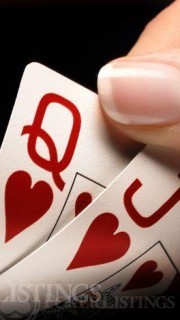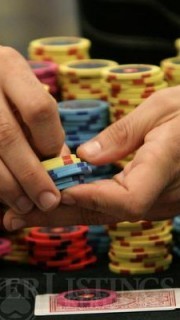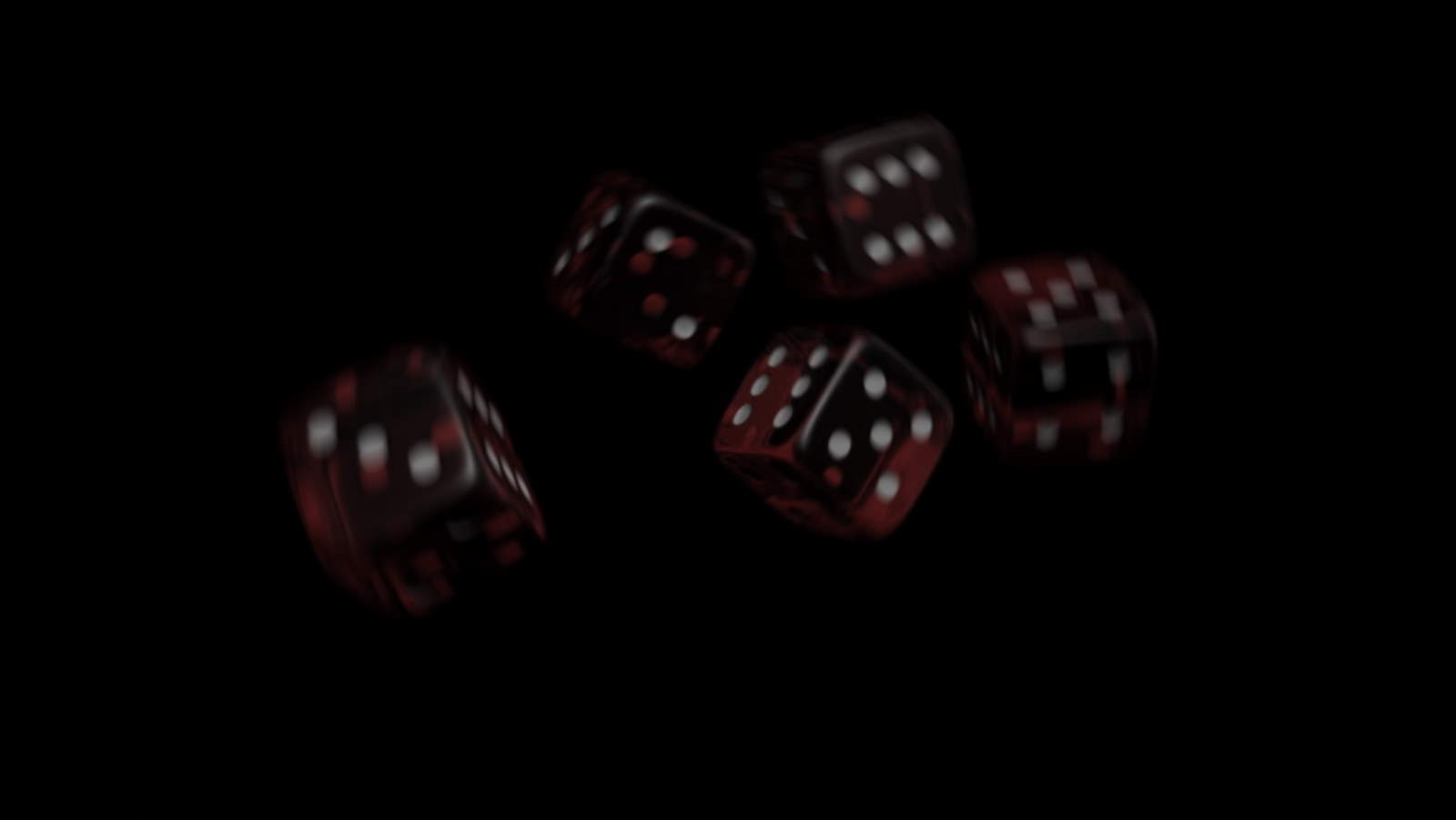They happen all the time so it’s important for you to know where you stand and how to play optimally in each of these situations.
If you can regularly make the correct decisions in these spots you’ll be a winner in the long run and you’ll be a superior player to those who get them wrong.
These are the most common standard situations you'll encounter in Texas Hold’em pre-flop, post-flop and on the turn with the key math explained along with the best approach for dealing with them.
Standard Equity Pre-Flop in Texas Holdem
1) The Coin Flip: One Pair vs Two Overcards
Examples: Q♠ Q♣ vs A♣ K♦; 8♦ 8♥ vs K♣ Q♥

This is probably the best known situation in NLHE. It’s generally called a coin flip with each player basically having a 50-50 chance of winning, although it really isn't quite so clear.
In reality the pocket pair is significantly ahead most of the time. The winning percentage of QQ vs AKo is 57:43, for example.
But there are also instances when the pair is behind (for example any low pair against JTs).
Hint: Coin flips are the bread and butter of tournament poker. Put your chips in the middle and don’t think about them too much. Numbers will even out in the long run.
2) Ouch: Higher Pair vs Lower Pair
Examples: Q♠ Q♣ vs 7♦ 7♠; 8♦ 8♥ vs 5♣ 5♥
This is a really bad spot if you have the lower pair. The higher pair is always an 82% favorite. There's nothing for you to do but pray.
Hint: The lower your pair, the higher the chances of being dominated. Eights are the pair that separates the small pairs from the big pairs.
3) Kicker issues: Not as Bad as You Think
Examples: A♦ K♣ vs A♣ Q♥; K♥ Q♦ vs K♠ T♥
“Being dominated," which means having a weaker kicker to your high card than your opponent, is not as bad a situation as many players think.
The better hand has about 70% equity, which means that the weaker hand actually wins almost every third time. The lower your kicker is, the lower also are the chances of it having any effect on the outcome as there will be more split pots.
Hint: With a bad kicker you always have to be aware that you might be dominated. However it’s a lot worse to run a pair into a higher pair.
4) Not Good at All: Pocket Pair vs One Overcard
Examples: Q♠ Q♣ vs A♦ T♠; 8♥ 8♦ vs A♣ 5♥
Another situation where the player with the overcard is in a really bad spot with just 27-32% equity. The good thing is that’s still more than every fourth time.
Hint: Be careful if you have a weak kicker. Chances are you’re not flipping but playing with only one live card.
Standard Equity Post-Flop in No-Limit Hold’em
1) Top Pair vs Flush Draw or Straight Draw
Examples: A♥ 2♥ vs K♣ Q♠ on a flop of K♥ T♣ 8♥; K♣ Q♠ vs 8♦ 7♥ on a flop of K♦ 9♣ 6♥
This is comparable to the so-called "coin flip" pre-flop. It’s important to notice that there are still two cards to come so the draw has two chances of coming in.
The flush draw in the example above has a 45% chance to win while the straight draw in the second example only has 33%.
The reason is because there are still nine hearts to complete the flush draw while there are only six cards that complete the straight draw.
Hint: The chances for your draws are determined by the pot odds. If you’re getting the right pot odds you can continue profitably.
2) A Big Advantage: Top Pair vs Lower Pair

Example: K♣ Q♠ vs J♥ T♦ on a flop of K♥ J♠ 2♣
A situation like this is about as one-sided as a higher vs a lower pair on the flop. The better hand is going to win 80% of the time.
Hint: Play pairs lower than top pairs very carefully. They don’t have a lot of chances to improve and are often dominated.
3) Top Pair vs Top Pair – Kicker Issues
Example: K♣ Q♠ vs K♥ T♥ on a flop of K♦ 7♦ 6♣
Having a lower kicker is even worse than having a lower pair. This shows how important the kicker card is.
The dominating hand has an 83% chance of winning so it's a clear favorite.
Hint: Be careful with a top pair, bad kicker hand. The lower your kicker the more often you’re behind.
4) Set vs Top Pair – Way Ahead
Example: 4♣ 4♠ vs A♥ K♥ on a flop of A♣ T♠ 4♦
You can’t be much more of a favorite. A set wins 96% of hands against top pair on the flop. It’s an almost unbeatable hand.
The higher the top pair is the harder it is to get rid of it. Many players “get married” to their top pair, which makes sets so incredibly profitable.
Hint: If you flop a set you’re pretty certain to be a winner. But watch out for possible draws!
5) Set vs Flush Draw or Straight Draw – a 3:1 Favorite
Examples: 4♣ 4♠ vs A♥ K♥ on a flop of 4♥ 9♥ 7♣; 4♣ 4♥ vs Q♥ on a flop of T♦ J♦ 7♣
This is one of the situations that pretty much plays out automatically. The set is a 3-1 favorite but the pot odds and implied odds are often so good that the draw can call profitably.
But remember: The set is always ahead on the flop.
Hint: You’re always a favorite with a set on a rainbow board. Note that you always have re-draws to a paired board even if the draw comes in first.

6) Set vs Monster Draw (Combined Flush and Straight Draw) – Still Ahead
Example: 4♣ 4♠ vs J♥ T♥ on a flop of 9♥ 8♥ 4♦
Although the drawing hand is now drawing to both a flush and a straight the set is still a 58-42 favorite – quite remarkable, isn’t it?
Yet both hands have a good reason to bet in this situation as the pot odds will almost always be good enough.
Hint: With a flopped set you’re going to be a favorite on the flop even against the best possible draw.
Related Reading:
Standard Equity in No Limit Hold’em – The Turn
The flop may have given you a pretty hand but if the turn is not what you’re looking for it can literally turn things around.

1) Top pair vs Flush Draw or Straight Draw
Examples: Flush draw A♥ 2♥ vs K♣ Q♠ on a board of K♥ T♣ 8♥ --- 3♦
Straight draw: K♣ Q♠ vs 8♦ 7♥ on a board K♦ 9♣ 6♥ 3♦
The flush draw with one overcard now is down to 28% equity (aka chance of winning). The straight has even less than 20%.
It follows that you usually have to fold the draws in case your opponent bets big.
Hint: Generally speaking you’ll always want to see the river with a draw but sometimes the pot odds won’t be good enough. That means the amount of chips you have to pay to call might be too high to be justified by the slim chances of hitting.
2) Top Pair vs Lower Pair – Almost Done
Example: K♣ Q♠ vs J♥ T♦ on a board of K♥ J♠ 2♣ --- 3♦
If the lower pair doesn’t find help on the turn you should rarely continue. In our example the pair of jacks has an 11% chance to win which doesn’t give you reason to bet.
Hint: Playing second pair is tricky as there are only a few ways for it to improve. They become even fewer on the turn.
3) Top Pair vs Top Pair – Domination Nation
Example: K♣ Q♠ vs K♥ T♥ on a board of K♦ 7♦ 6♥ --- 2♠
Kicker issues often get worse on every street, i.e. with every new community card. The situation described above leaves the weaker hand only a 7% shot at winning – so little that it doesn’t justify any call.
Hint: If your pair is dominated, meaning your opponent has a higher second card (=kicker), you’re in dire straits. If you’re behind you’re only going to win one out of 10 times.
4) Set vs Top Pair – Decided
Example: 4♣ 4♠ vs A♥ K♥ on a board of A♣ T♠ 4♦ --- 2♠
If the turn hasn’t helped your top pair hand the hand is already over. There is no way to overtake the set on the river.
Note that in the example above another ace on the board would give the player with pocket fours a full house.
Hint: With a set you’re dominating the hand on the turn. On the other side of the table, against a set you’re lost.
5) Set vs Flush Draw or Straight Draw – Almost Unstoppable
Example: 4♠ 4♣ vs A♥ K♥ on a board of 4♥ 9♥ 7♣ 2♠
If you’re playing a draw and you don’t hit the turn your chances are down to 16%.
However you might not notice it as your overcards look like outs, too.
Hint: Overcards can bedeceptive as you lose even if you hit one of them. These can't be considered “full” outs.
6) Set vs Combo Draw – Call
Example: 4♣ 4♠ vs J♥ T♥ on a board of 9♥ 8♥ 4♦ --- 2♣
If you’re playing a draw that's both a flush and a straight draw, and it doesn’t fill up on the turn, you’re down to 30%.
However this is usually enough to call as you can win even more money on the river if you still hit. In this example there is also a straight flush draw added.
Hint: With such a strong draw as this you should always try to get to the river. This kind of hand has too many outs to be folded.
The Rule of Four and Two – How to Calculate Your Equity
Equity, as mentioned before, is your winning chance in percent. The rule of four and two is a simple way to calculate the equity of your hand. It’s not exact, but it’s close enough.
It’s one of the first rules players learn and if you’re not familiar with it yet you should memorize it quickly.
Rule of Four

Applies on the flop. If you have a flush draw that means there are nine cards in the deck that give you the winning hand.
Multiply the number of your outs by 4 and the result is your approximate equity – 36%.
Rule of Two
Applies on the turn. If the turn card hasn’t helped your flush draw you can now calculate your equity by multiplying the number of your outs by 2 and add 2.
Your chances to win are now approximately 20%.
One final note: These numbers vary slightly depending on what cards the opponent has.
If the opponent has a set, for example, some of the flush outs will give him a full house.






Standard Equity Post-Flop in No-Limit Hold’em
1) Top Pair vs Flush Draw or Straight Draw
Examples: A♥ 2♥ vs K♣ Q♠ on a flop of K♥ T♣ 8♥; K♣ Q♠ vs 8♦ 7♥ on a flop of K♦ 9♣ 6♥
This is comparable to the so-called “coin flip” pre-flop. It’s important to notice that there are still two cards to come so the draw has two chances of coming in.
I believe the statement and math is incorrect.
It should be 9 outs for flush draw which comes out to 38% approx and 8 outs for the straight draw which is 32% approx based on 2% for each card
The flush draw in the example above has a 45% chance to win while the straight draw in the second example only has 33%.
The reason is because there are still nine hearts to complete the flush draw while there are only six cards that complete the straight draw.
Didn’t realise I was a beginner until I saw this,,,very insightful and appreciate the content,,thank you
I have a question maybe you could answer for me!
How much of a bankroll is needed to play $2 big blind?
Hey Gordon, thanks for the feedback and question.
You’ll need at least 20 big blinds for a cash game, although many prefer 40-50 blinds. So you can be playing with anything between $40-$100 in your case. We cover poker bankroll management more extensively in the following articles:
How Big of a Bankroll?
Having a Proper Bankroll